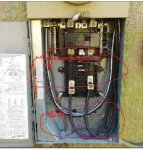jsherwin
Member
- Location
- cocoa, fl, usa
I have a scenario where an installer wants to interconnect a pv inverter to an integrated meter / service panel with 4 spaces available for load breakers and feed through lugs at the bottom. The ocpd for the integrated meter/service panel is 150 amps (which is the busbar rating as well) and it feeds a 150 amp load center (with 150 amp ocpd) via the feed through lugs . The inverter Imax is 32 amps and ocpd is 40 amps. The 40 amp inverter breaker will go in spaces between the 150 amp main ocpd and the 150 amp load center ocpd. A label will be applied to the integrated panel saying that no additional breakers can be installed.
Question: This connection cannot be made under 705.12(D)(2)(3)(a)-(c) however, the busbar on the integrated panel will never see more than 150 amps per the breakers at the meter and load center. Essentially, the busbar is a 150 amp rated feeder to the load center in the garage. By putting the 40 amp ocpd in the empty slots, you are essentially making a "tap" on that feeder. Therefore, interconnecting the inverter to the empty slots in that integrated panel would be nothing more that a tap connection. Is this a code compliant interconnection despite the 705.12(D)(2)(3)(a)-(c) rules?
Question: This connection cannot be made under 705.12(D)(2)(3)(a)-(c) however, the busbar on the integrated panel will never see more than 150 amps per the breakers at the meter and load center. Essentially, the busbar is a 150 amp rated feeder to the load center in the garage. By putting the 40 amp ocpd in the empty slots, you are essentially making a "tap" on that feeder. Therefore, interconnecting the inverter to the empty slots in that integrated panel would be nothing more that a tap connection. Is this a code compliant interconnection despite the 705.12(D)(2)(3)(a)-(c) rules?


